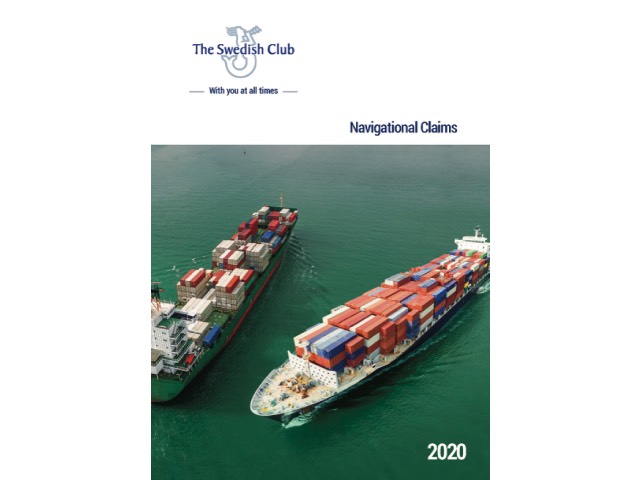Containers tumbling into the sea, environmental damage – with reports of navigational error a seeming fact of life The Swedish Club has launched a new edition of Navigational Claims, which aims to provide an insight into the causes of these incidents and offers comprehensive loss prevention advice in order to avoid them.
The Swedish Club’s Loss Prevention team has reviewed its claims history, using its comprehensive bank of statistics to publish an insight into the latest trends, provide detailed case studies, highlight relevant International Regulations for Preventing Collisions at Sea (COLREGS), and share commentary from a qualified pilot with first-hand experience of issues during port transit.
With navigational errors contributing to almost a third of the Club’s H&M claims portfolio, Lars A. Malm, Director Strategic Business Development & Client Relations at The Swedish Club, is in no doubt as to the seriousness of these incidents: “Collisions, contact, groundings – even the loss of the Costa Concordia, the most expensive marine insurance claim in history, and a tragic loss of life – was due to navigational error,” he says.

“We have seen, and continue to see, that many such incidents are caused by ‘the human element’ – individuals and teams making serious misjudgements in situations that could not be described as extreme.”
Navigational Claims highlights the following:
• Container vessels are top of the league for collisions and contact claims and are responsible for about 37% of the collision claims and 42% of the contact claims that the Club sees. They have double the frequency of contacts and collisions than bulkers, often carrying out manoeuvres close to the berth at high speed. The most expensive claims occur when a vessel hits a gantry crane or the quay at high speed.
• Frequency of collision is highest on RoRos, and frequency of contact highest on passenger ferries. Most of these incidents happen within the port area – RoRo vessels mostly trade short distances between specific ports, which means that they have more port calls than the more conventional merchant vessels.
• Bulk vessels have the greatest frequency of groundings which may be because they may trade in more difficult conditions, often loading ore and other material which can be sourced from a remote island or port.
• Despite the fact that the pilot joins the vessel to increase safety, it can also be seen that more than half (55%) of all navigational claims occur when the pilot is on board.
Whilst the causes of such incidents may seem diverse, the loss prevention advice is very clear:
“The causes are numerous,” explains Malm. “Many can be prevented by efficient communication, planning, and understanding the limitations and risks with the navigational equipment. Often officers have very different
backgrounds, experience and knowledge. It is also common that the bridge team does not work in harmony. We hope that Navigational Claims will highlight some of the common problem areas and raise awareness of the steps that can be taken to overcome them.”
Navigational Claims is the latest Loss Prevention publication from The Swedish Club. For your copy visit https://www.swedishclub.com/films-and- publications/publications/loss-prevention-and-brochures/









































